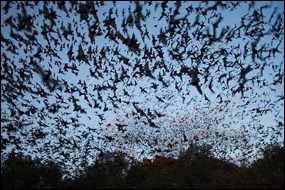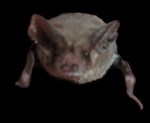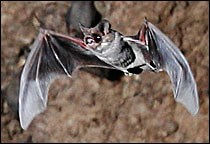
USFWS photo by Ann Froschauer Brazilian free-tailed bats (Tadarida brasiliensis) occur throughout the southern United States and southward to the Caribbean Islands, Mexico and Central America, and northern South America. Brazilian free-tailed bats are so named because they migrate from the United States to as far as Brazil during the winter. Florida, however, lacks large caverns to offer as bat habitat. Caves in Florida typically contain water, which raises the humidity of the air space above the tolerance level for free-tailed bats. Instead, southeastern free-tailed bats commonly roost in buildings and under bridges in urban areas, where they form relatively large colonies with individuals typically numbering in the hundreds to thousands. Roosting together in large colonies allows baby bats, called pups, to remain behind in the warmth, comfort, and safety of the colony while the mothers leave the roost to feed. 
Photo © Hank and Marsha Rhodes Another difference between the two subspecies is that the southeastern free-tailed bats do not migrate. Seasonal temperature variation within Florida's warm climate is minimal, which also allows for year-round availability of food. With less severe physical conditions to endure, tropical and subtropical bat species display a greater variety of behaviors than bats that inhabit temperate zones. Although free-tailed bats in Florida do not hibernate, during winter cold spells they typically go into a state of torpor. When temperatures are low and food is scarce, torpor allows bats to combat energy loss by slowing down their bodily functions, thereby stopping production of body heat and slowing down their metabolism and heart and breathing rate to extremely low levels. 
Photo courtesy of the State of Florida In the family Molossidae, free-tailed bats are so named because the end of their tail visibly extends beyond the edge of the tail membrane. All of Florida's other bat species are in the family Vespertilionidae, in which the tail extends only as far as the tail membrane and is therefore not as noticeable. Brazilian free-tailed bats primarily eat insects, including moths, beetles, and flies.They hunt their prey using echolocation and typically catch their prey in flight. |
Last updated: January 2, 2022
